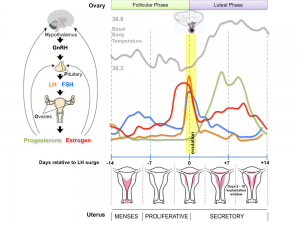Reproductive Cycles
Introduction
Sexual reproduction in most species is regulated by regular endocrine changes, or cycles, in the female. These cycles begin postnatally, function for variable times and can then decrease or cease entirely. There are a number of different species-specific female hormonal cycles which can regulate reproduction.
Menstrual Cycle
Human reproduction is regulated in females the menstrual cycle, a regular cyclic hormonal change which coordinate changes in the ovary and internal reproductive tract.
This cycle commences at puberty and ends at menopause.
- Links: Menstrual Cycle | Ovary Development | Uterus Development | Puberty
Estrous Cycle
The estrous cycle (British spelling, oestrous) is the main reproductive cycle of females of other non-primate species vertebrates.
For example: rats, mice, horses, pigs all have this form of reproductive cycle.
- Links: Estrous Cycle | Mouse Estrous Cycle |
There are also a variety of different estrous forms:
- Polyestrous Animals - Estrous cycles throughout the year (cattle, pigs, mouse, rat).
- Seasonally Polyestrous Animals - Animals that have multiple estrous cycles only during certain periods of the year (horses, sheep, goats, deer, cats).
- Monestrous Animals - Animals that have one estrous cycle per year (dogs, wolves, foxes, and bear)
Glossary Links
- Glossary: A | B | C | D | E | F | G | H | I | J | K | L | M | N | O | P | Q | R | S | T | U | V | W | X | Y | Z | Numbers | Symbols | Term Link
Cite this page: Hill, M.A. (2024, April 23) Embryology Reproductive Cycles. Retrieved from https://embryology.med.unsw.edu.au/embryology/index.php/Reproductive_Cycles
- © Dr Mark Hill 2024, UNSW Embryology ISBN: 978 0 7334 2609 4 - UNSW CRICOS Provider Code No. 00098G


